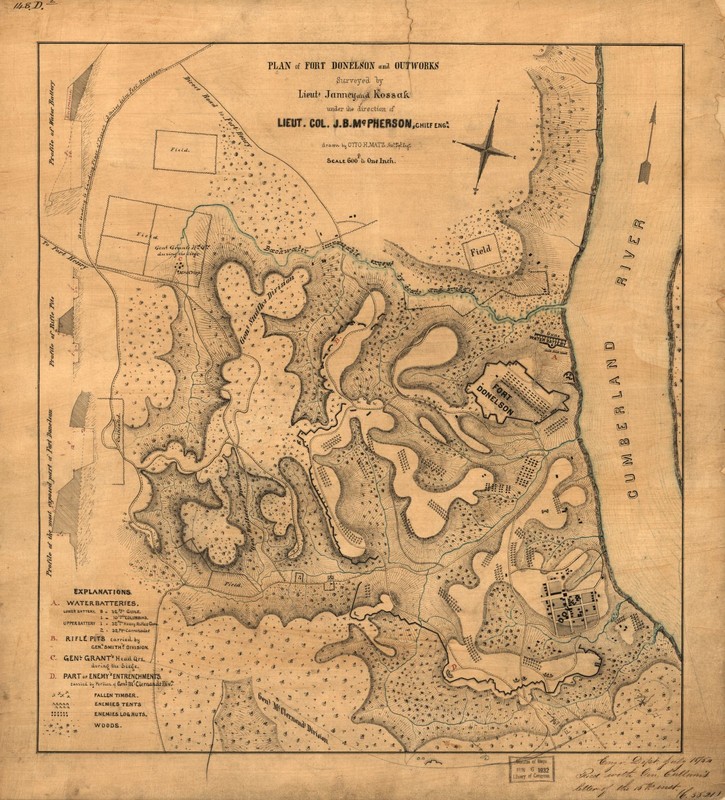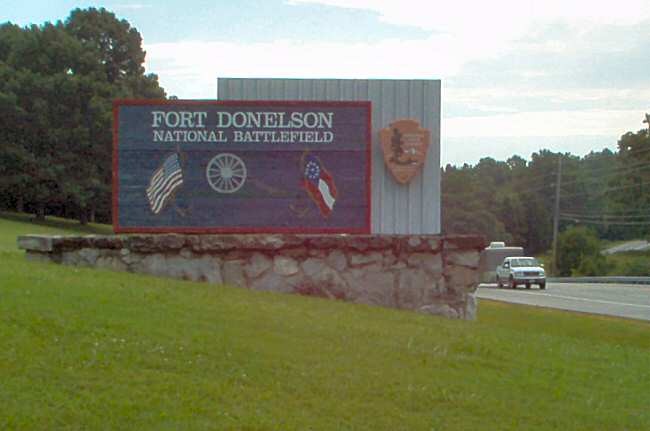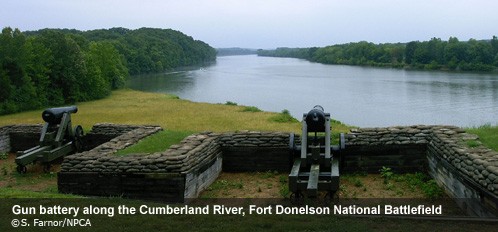Fort Donelson National Battlefield
Introduction
Text-to-speech Audio
Images
Battlefield map of the Battle of Fort Donelson

Welcome sign for Fort Donelson National Battlefield

Cannons overlooking the Cumberland River

Backstory and Context
Text-to-speech Audio
After Kentucky decided to remain a border state, Confederate military leaders planned defensive points along rivers bordering the Tennessee-Kentucky line. Fort Donelson and nearby Fort Henry were constructed to protect western Tennessee from Union advancement. 1 In 1862, Brigadier General Ulysses S. Grant devised a plan to advance on Fort Henry in order to attack before Confederate reinforcements arrived. As Grant’s army advanced south, Union Flag Officer Andrew Foote planned to attack Confederate forts along the Tennessee River.2 After a brief exchange of gunfire, the Union army quickly took control of Fort Henry and Grant planned to advance on nearby Fort Donelson, which was on the Cumberland River. Grant’s advancement was delayed because of poor weather, waiting for reinforcements, and slow moving troops.3
Confederate General Albert Sidney Johnston sent new reinforcements to Fort Donelson and appointed Brigadier General John Floyd as the new commander of the fort.4 By the morning of February 13th, Grant’s forces surrounded the vicinity of the fort. The cold wind and the snow caused both armies to have a worsening morale. Grant’s army blocked the land side of the fort and the Confederate forces were trapped within the walls of the fort. On February 14th, Foote’s ironclad gunboats advanced along the Cumberland River and arrived at Fort Donelson.5 The ironclads and the Confederate forces exchanged gunfire and Foote retreated along the river. While Grant was planning a siege of the fort, the Confederates were planning to place all the forces along the right side of the Union forces and force a break in the Union line.6 In the morning of February 15th, the Confederate forces drove the Union forces back from their landward position. The Union army was seemingly about to lose the battle.
On the morning of February 15th, Confederate Brigadier General Gideon Pillow ordered the Confederate troops from the earthenworks, which caused them to lose all the ground they had gained.7 General Grant sent more troops to the Confederate side which had mounted the heaviest attack on his forces. Grant had reinforcements arriving each day, which made the Confederates’ plan less likely to be successful. General Pillow and General Floyd relinquished control to Simon Buckner and headed for Nashville with around 2,000 troops.8 Other troops accompanied Colonel Nathan Bedford across the river to retreat. Buckner sent word to Grant asking about the terms for surrender and, on February 16th, Buckner’s troops unconditionally surrendered to Grant’s army.9
In the aftermath of the surrender, civilians and relief agencies arrived to help the Union army with medical supplies, food, and hospital transportation. Local civilian, Mary Bickerdyke, acted as a nurse and cared for the wounded soldiers.10 The capture of Fort Donelson and the nearby Fort Henry gave the Union its first major victory and led to fame for Grant, who was subsequently promoted to major general. Later victories at Shiloh, Vicksburg, and Chattanooga led to Grant being promoted to lieutenant general and commander of the whole Union Army.11 The defeat at Fort Donelson caused the South to cede territory in southern Kentucky, middle Tennessee, and western Tennessee. The Union gained control of the railroads in the region and Nashville was converted into a supply depot for the Union army.
Visitors can tour the battlefield grounds, which are part of the Fort Donelson National Battlefield, which is maintained by the National Park Service. The park is located near Dover, Tennessee and has a visitor’s center with exhibits and displays about the battle. Visitors can also check out the Dover “Surrender House” which includes an informative film about the battle and the different individuals involved in the battle.
Cite This Entry
Caudill, Lynsey. "Fort Donelson National Battlefield ." Clio: Your Guide to History. July 27, 2016. Accessed April 15, 2025. https://theclio.com/entry/24636

